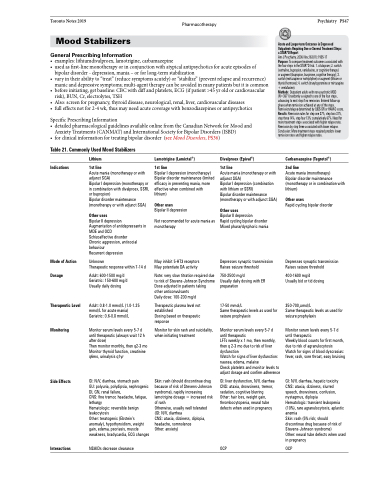Page 1211 - TNFlipTest
P. 1211
Toronto Notes 2019
Pharmacotherapy
Psychiatry PS47
Mood Stabilizers
General Prescribing Information
• examples: lithiumdivalproex, lamotrigine, carbamazepine
• usedasfirst-linemonotherapyorinconjunctionwithatypicalantipsychoticsforacuteepisodesof
bipolar disorder - depression, mania – or for long-term stabilization
• vary in their ability to “treat” (reduce symptoms acutely) or “stabilize” (prevent relapse and recurrence)
manic and depressive symptoms; multi-agent therapy can be avoided in many patients but it is common
• beforeinitiating,getbaseline:CBCwithdiffandplatelets,ECG(ifpatient>45yroldorcardiovascular
risk), BUN, Cr, electrolytes, TSH
• Also:screenforpregnancy,thyroiddisease,neurological,renal,liver,cardiovasculardiseases
• fulleffectsnotfor2-4wk,thusmayneedacutecoveragewithbenzodiazepinesorantipsychotics
Specific Prescribing Information
• detailedpharmacologicalguidelinesavailableonlinefromtheCanadianNetworkforMoodand
Anxiety Treatments (CANMAT) and International Society for Bipolar Disorders (ISBD) • for clinical information for treating bipolar disorder (see Mood Disorders, PS36)
Acute and Longer-term Outcomes in Depressed Outpatients Requiring One or Several Treatment Steps: a STAR*D Report
Am J Psychiatry. 2006 Nov;163(11):1905-17
Purpose: To compare treatment outcomes associated with the four steps in the STAR*D trial. 1. citalopram; 2. switch (sertraline, bupropion, venlafaxine, or cognitive therapy)
or augment (bupropion, buspirone, cognitive therapy); 3. switch (mirtazapine or nortriptyline) or augment (lithium or thyroid hormone); 4. switch (tranylcypromine or mirtazapine +venlafaxine).
Methods: Outpatient adults with non-psychotic MDD (N=3671) randomly assigned to one of the four steps, advancing to next step if no remission. Entered follow-up phase when remission achieved at any of the steps. Remission/relapse determined by QIDS-SR or HAM-D score. Results: Remission rates for step one 37%, step two 31%, step three 14%, step four 13%; cumulatively 67%. Need for more treatment steps associated with higher relapse rate. Remission by step three associated with lower relapse. Conclusion: More treatment steps required predicts lower remission rates and higher relapse rates.
Carbamazepine (Tegretol®)
2nd line
Acute mania (monotherapy)
Bipolar disorder maintenance (monotherapy or in combination with lithium)
Other uses
Rapid cycling bipolar disorder
Depresses synaptic transmission Raises seizure threshold
400-1600 mg/d
Usually bid or tid dosing
350-700 μmol/L
Same therapeutic levels as used for seizure prophylaxis
Monitor serum levels every 5-7 d until therapeutic
Weekly blood counts for first month, due to risk of agranulocytosis
Watch for signs of blood dyscrasias: fever, rash, sore throat, easy bruising
GI: N/V, diarrhea, hepatic toxicity CNS: ataxia, dizziness, slurred speech, drowsiness, confusion, nystagmus, diplopia
Hematologic: transient leukopenia (10%), rare agranulocytosis, aplastic anemia
Skin: rash (5% risk; should discontinue drug because of risk of Stevens-Johnson syndrome)
Other: neural tube defects when used in pregnancy
OCP
Table 21. Commonly Used Mood Stabilizers
Indications
Lithium
1st line
Acute mania (monotherapy or with adjunct SGA)
Bipolar I depression (monotherapy or in combination with divalproex, SSRI, or bupropion)
Bipolar disorder maintenance (monotherapy or with adjunct SGA)
Other uses
Bipolar II depression
Augmentation of antidepressants in MDE and OCD
Schizoaffective disorder
Chronic aggression, antisocial behaviour
Recurrent depression
Unknown
Therapeutic response within 7-14 d
Adult: 600-1500 mg/d Geriatric: 150-600 mg/d Usually daily dosing
Adult: 0.8-1.0 mmol/L (1.0-1.25 mmol/L for acute mania) Geriatric: 0.6-0.8 mmol/L
Monitor serum levels every 5-7 d until therapeutic (always wait 12 h after dose)
Then monitor monthly, then q2-3 mo Monitor thyroid function, creatinine q6mo, urinalysis q1yr
GI: N/V, diarrhea, stomach pain
GU: polyuria, polydipsia, nephrogenic DI, GN, renal failure,
CNS: fine tremor, headache, fatigue, lethargy
Hematologic: reversible benign leukocytosis
Other: teratogenic (Ebstein’s anomaly), hypothyroidism, weight gain, edema, psoriasis, muscle weakness, bradycardia, ECG changes
Lamotrigine (Lamictal®)
1st line
Bipolar I depression (monotherapy) Bipolar disorder maintenance (limited efficacy in preventing mania, more effective when combined with lithium)
Other uses
Bipolar II depression
Not recommended for acute mania as monotherapy
May inhibit 5-HT3 receptors May potentiate DA activity
Note: very slow titration required due to risk of Stevens-Johnson Syndrome Dose adjusted in patients taking other anticonvulsants
Daily dose: 100-200 mg/d
Therapeutic plasma level not established
Dosing based on therapeutic response
Monitor for skin rash and suicidality, when initiating treatment
Skin: rash (should discontinue drug because of risk of Stevens-Johnson syndrome), rapidly increasing lamotrigine dosage = increased risk of rash
Otherwise, usually well tolerated (GI: N/V, diarrhea
CNS: ataxia, dizziness, diplopia, headache, somnolence
Other: anxiety)
Divalproex (Epival®)
1st line
Acute mania (monotherapy or with adjunct SGA)
Bipolar I depression (combination with lithium or SSRI)
Bipolar disorder maintenance (monotherapy or with adjunct SGA)
Other uses
Bipolar II depression
Rapid cycling bipolar disorder Mixed phase/dysphoric mania
Depresses synaptic transmission Raises seizure threshold
750-2500 mg/d
Usually daily dosing with ER preparation
17-50 mmol/L
Same therapeutic levels as used for seizure prophylaxis
Monitor serum levels every 5-7 d until therapeutic
LFTs weekly x 1 mo, then monthly, then q 2-3 mo due to risk of liver dysfunction
Watch for signs of liver dysfunction: nausea, edema, malaise
Check platelets and monitor levels to adjust dosage and confirm adherence
GI: liver dysfunction, N/V, diarrhea CNS: ataxia, drowsiness, tremor, sedation, cognitive blurring
Other: hair loss, weight gain, thrombocytopenia, neural tube defects when used in pregnancy
Mode of Action Dosage
Therapeutic Level
Monitoring
Side Effects
Interactions
NSAIDs decrease clearance
OCP


